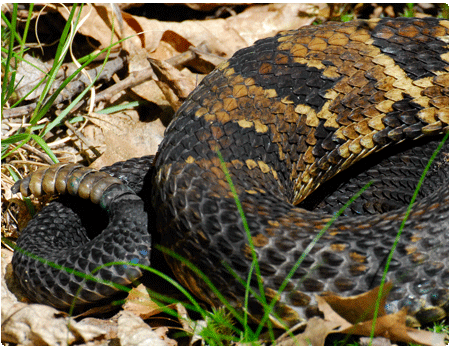
The Timber Rattlesnake is an endangered species in Vermont and is protected by law against killing, harming, and harassment.
In our state, rattlesnakes are most likely to be encountered during June–September as they migrate and forage miles from their overwintering den. Currently, there are only two confirmed populations in the state, and both are in Rutland County. Historically, they had a much wider distribution in Vermont.
Timber Rattlesnake bites are very rare, especially in Vermont where there are so few populations. These snakes would much rather go unnoticed and be left alone than defend themselves against a perceived predator or threat. In other states, where the species is more common, bites are frequently associated with alcohol use (by humans) and attempted handling.
The Response Program – Protecting Vermonters and Rattlesnakes
Vermont’s Rattlesnake Response Program is a FREE service that aims to protect Vermont residents and Timber Rattlesnakes by safely moving nuisance rattlesnakes away from private and public property. Since the program began in 2004, Vermont’s dedicated rattlesnake responders have safely moved dozens of rattlesnakes while informing residents about Timber Rattlesnake facts, myths, and benefits.
If you find a rattlesnake on your property, do not attempt to handle or move it yourself. If you would like the snake to be moved, call one of the responders listed below. All responders have been trained to safely handle rattlesnakes and are usually able to respond quickly. If a responder does not answer their phone, leave a voicemail and call another responder.
- Paul Jardine, Volunteer: 802-579-0058
- Lisa Jacobson, Volunteer: 802-282-3850
- Murray McHugh, The Nature Conservancy: 802-613-7383
- Luke Groff, Vermont Fish & Wildlife: 802-760-0089
- Warden Louis Daversa, Vermont Fish & Wildlife: 802-595-9034

Is It a Timber Rattlesnake?
Vermont’s Timber Rattlesnakes have a black, brown, tan, or yellow body color that fades to black near their tail. The species is thick bodied with dark V- or W-shaped crossbands that may not be apparent on black individuals.
Juveniles and adults are typically 2 to 4 feet long, with newborns being 8 to14 inches long. The Timber Rattlesnake is the only species in the state that has a rattle on the end of its tail. The rattle is comprised of one or more loose, interlocking, keratinized segments that, when vibrated, create a rattling sound.
The Timber Rattlesnake is the only native rattlesnake and venomous snake in Vermont; however, it is not the only species that rattles its tail. Eastern Milksnakes and Eastern Ratsnakes also vibrate their tails when threatened and, when vibrating against dry leaves, stones, etc., this can sound a lot like the rattling of a Timber Rattlesnake.
Additionally, many snakes will flatten their heads in a defensive display when threatened. This display can make the heads of non-venomous snakes appear triangular, which is an attribute typically associated with venomous snakes. For this reason, head shape is not a reliable diagnostic for identifying Timber Rattlesnakes.
Have Questions?
Contact Luke Groff, Vermont Fish & Wildlife biologist
Email: lukegroff@vermont.gov
Phone: 802-760-0089
Office Address: 271 North Main Street, Suite 215, Rutland, Vermont 05701
You Can Help – Report a Sighting
If you encounter a Timber Rattlesnake (or any reptile or amphibian for that matter), please consider submitting your observation to the Vermont Reptile and Amphibian Atlas
These submissions help resource managers better understand reptile and amphibian distributions and better conserve and protect populations and species.
